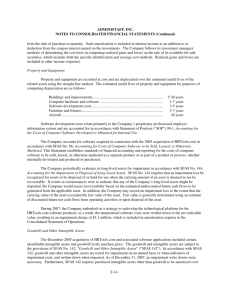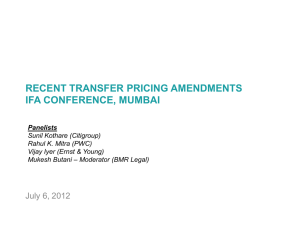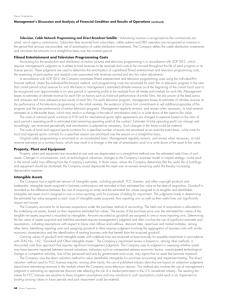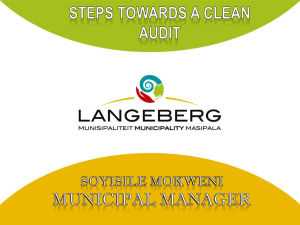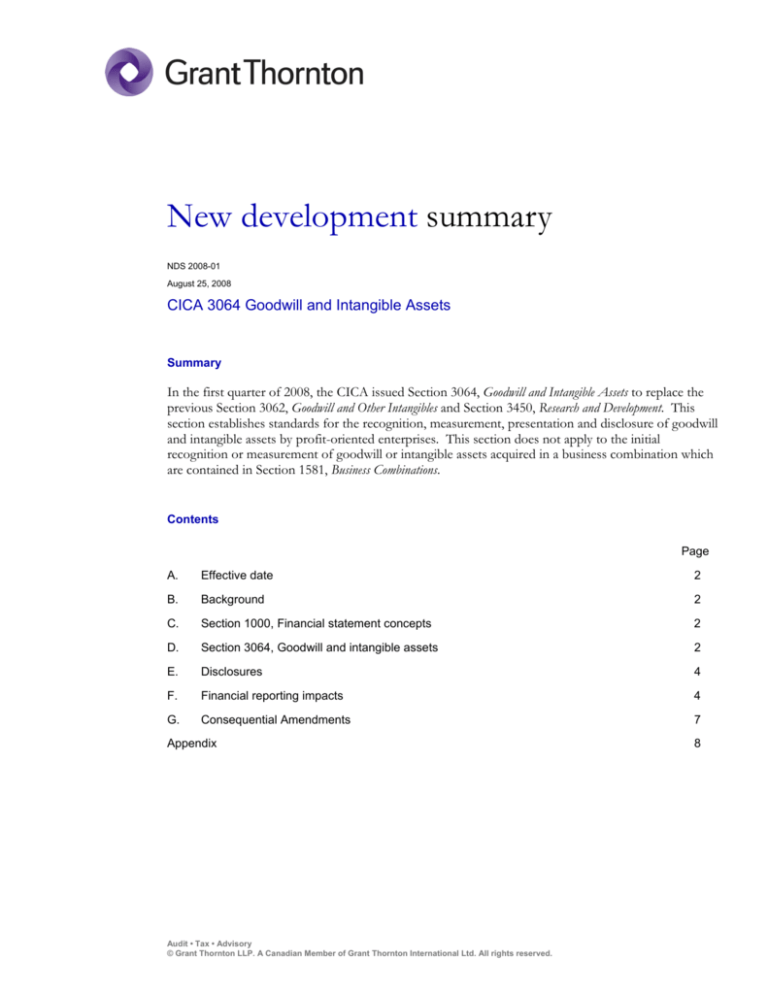
New development summary
NDS 2008-01
August 25, 2008
CICA 3064 Goodwill and Intangible Assets
Summary
In the first quarter of 2008, the CICA issued Section 3064, Goodwill and Intangible Assets to replace the
previous Section 3062, Goodwill and Other Intangibles and Section 3450, Research and Development. This
section establishes standards for the recognition, measurement, presentation and disclosure of goodwill
and intangible assets by profit-oriented enterprises. This section does not apply to the initial
recognition or measurement of goodwill or intangible assets acquired in a business combination which
are contained in Section 1581, Business Combinations.
Contents
Page
A. Effective date
2 B. Background
2 C. Section 1000, Financial statement concepts
2 D. Section 3064, Goodwill and intangible assets
2 E. Disclosures
4 F. Financial reporting impacts
4 G. Consequential Amendments
7 Appendix
Audit • Tax • Advisory
© Grant Thornton LLP. A Canadian Member of Grant Thornton International Ltd. All rights reserved.
8 NDS 2008-01
A.
2
Effective date
This Section applies to interim and annual financial statements relating to fiscal years beginning on or
after October 1, 2008. Earlier adoption is encouraged. An entity must apply the change retroactively.
Intangible assets recognized prior to the fiscal year beginning on or after October 1, 2008 that do not
meet the recognition or measurement criteria are accounted for in accordance with Section 1506,
Accounting Changes. An intangible item that was initially recognized as an expense should not be
recognized as part of the cost of an intangible asset on transition to this Section.
B.
Background
In December 2005 the AcSB issued an Exposure Draft on proposed amendments to Section 1000,
Financial Statement Concepts and Section 3062, Goodwill and Other Intangibles. The proposals were
reconsidered after the March 2006 release by the AcSB of their Strategic Plan “Accounting Standards in
Canada: New Directions”. Ultimately this new Section 3064 was issued and provides the first step to a
converged Canadian/IFRS standard as it is the Canadian equivalent to International Financial
Reporting Standard IAS 38, Intangible Assets. The recognition criteria for research and development
costs from previous Section 3450 have been retained. The provisions relating to subsequent
measurement and disclosure of goodwill and intangible assets from previous 3062 have been retained
and renumbered.
The IASB and FASB have commenced a project regarding intangible assets (excluding goodwill). The
project is expected to focus on initial recognition criteria and subsequent accounting. To date there
have been no exposure drafts or updates on the project.
C.
Section 1000, Financial statement concepts
The AcSB also made an amendment to Section 1000, Financial Statement Concepts to delete guidance
previously interpreted to support the appropriateness of deferral of costs. In the past, expenses would
be deferred on the basis of the matching principle. Going forward, expenses can only be capitalized if
they meet the definition of an asset or the criteria for recognition.
By removing the referenced comments Canadian practice will restrict the expenditures which qualify
for recognition as an asset and be more in line with International and US standards and practices.
D.
Section 3064, Goodwill and intangible assets
Scope
This section applies to all intangibles with the exception of: (1) intangible assets acquired in a business
combination; (2) intangibles revalued as part of a comprehensive revaluation (3 )inventories; (4)
activities that are unique to enterprises in the extractive industries; (5) leases within the scope of Section
3065; (6) employee benefit assets; (7) future income tax assets; (8) non-current intangible assets held for
sale; (9) financial assets; (10) balances deferred by life insurance enterprises in accordance with Section
4211; (11) not for profit organizations; (12) servicing assets.
Audit • Tax • Advisory
© Grant Thornton LLP. A Canadian Member of Grant Thornton International Ltd. All rights reserved.
NDS 2008-01
3
Recognition and measurement
The standard prescribes that an intangible asset should be recognized only if the asset is identifiable (i.e.
meets the identifiability criterion), the entity has control of the asset, the asset is expected to generate
future economic benefits and the costs can be reliably measured. The intangible asset should be initially
measured at cost. Costs include directly attributable amounts required to acquire, create, produce and
prepare the asset to be capable of operating in the manner intended. (Note it is “to be capable of” not
“when put to use”.)
The standard discusses the appropriate accounting for separately acquired intangible assets and for
internally generated goodwill and intangible assets. Separately acquired goodwill would be in the scope
of Section 1581 not this Section 3064.
Separately acquired intangible assets
The purchase transaction completion automatically satisfies the recognition criteria because the
negotiation and price agreed upon by both parties reflect the presumptions that the benefits will flow to
the entity and the price demonstrates the measurement.
Internally generated intangible assets
The creation of internally generated intangible assets may be split into separate phases:
1
The research phase which refers to activities of an investigative nature for the purposes of gaining
new knowledge. Costs incurred with this intention cannot be separated or controlled by the entity
and therefore do not meet the criteria for capitalization and should be expensed.
2
The development phase which refers to the application of information (ie. research) to create new
materials, products, processes, etc. prior to commercial production or use. The criteria for
classification as a development activity are consistent with the superseded Section 3450, Research
and Development. Costs classified as development costs may be capitalized.
Other activities are often carried on by an entity with the intention that they will provide future
economic benefits to the entity. These activities include start-up costs, training, advertising and
promotional and relocating / reorganizing of part or all of the entity. These types of costs do not meet
the recognition criteria and should be expensed.
The impact of the new Section would be to prohibit the common deferral of start-up / pre-operating
expenditures. This change would bring Canadian GAAP more in line with that of IFRS and US
GAAP. However, there are still differences between the standards. Please refer to the Appendix for a
brief overview.
Audit • Tax • Advisory
© Grant Thornton LLP. A Canadian Member of Grant Thornton International Ltd. All rights reserved.
NDS 2008-01
E.
4
Disclosures
The amended and new sections have not resulted in significant disclosure changes. For internal
intangible assets subject to amortization an entity must distinguish between those which were acquired
and those which were internally developed.
F.
Financial reporting impacts
Companies will find that:
• Deferral may only be achieved if the item meets the criteria of an asset or liability.
• Costs previously capitalized may not meet the new criteria for capitalization and will be treated as an
error and require retrospective treatment.
• Costs associated with intangible assets previously recognized as an expense cannot be recognized as
an asset on a retrospective basis.
• Costs associated with intangible assets previously recognized as an expense, on a prospective basis
will be recognized as an asset.
Sample note disclosures
(Please note these require customization to meet the company circumstance)
Situation A: Recent accounting changes notes
With no assessment of impact:
Future accounting Changes
In February 2008, the CICA issued Section 3064, “Goodwill and Intangible Assets”, which
replaced existing Section 3062, “Goodwill and Other Intangible Assets” and Section 3450,
“Research and Development”. The new standard provides guidance on the recognition,
measurement, presentation and disclosure of goodwill and intangible assets. This standard is
effective for interim and annual financial statements relating to fiscal years beginning on or
after October 1, 2008 and is applicable for the Company’s first quarter of fiscal 2009. The
Company is currently evaluating the impact of this new standard.
With assessment of impact:
Future accounting changes
The CICA released the following new standard that will apply to the company’s financial
statements for the year commencing December 1, 2008. Section 3064, “Goodwill and
Intangible Assets”. This section establishes standards for recognition, measurement,
presentation and disclosure of goodwill and intangible assets.
The company has determined that deferred charges in the amount of $1,000,000 may not meet
the criteria for deferral with the adoption of CICA Handbook Section 3064 for the fiscal year
Audit • Tax • Advisory
© Grant Thornton LLP. A Canadian Member of Grant Thornton International Ltd. All rights reserved.
NDS 2008-01
5
beginning December 1, 2008. Accordingly with the adoption of this standard the company will
account for the unamortized portion of these costs as outlined under the transitional
provisions.
Situations B: Accounting policy notes
In the year of adoption or the first year of application:
Intangible assets
The Company capitalizes the costs associated with the initial acquisition or development of
intangible assets. Costs include directly attributable expenditures necessary to acquire, produce
and prepare the asset to the point of capability to operate in the manner intended. Once an
item is capable of operation in the manner intended the cost is amortized to income on a
straight line basis over its anticipated useful life, unless it is determined to have an infinite live.
For all intangible assets the Company assesses on an annual basis whether there is impairment
in value, and if it is determined that impairment exists, the asset is written down to the best
estimate of fair value.
Other intangible assets and research and development activities
Other intangible assets include acquired and internally developed software used in production
or administration. They are accounted for using the cost model whereby capitalized costs are
amortized on a straight line basis over their estimated useful lives (three to five years), as these
are considered finite. In addition, they are subject to impairment testing as described in the
impairment policy note.
Acquired computer software licenses are capitalized on the basis of the costs incurred to
acquire and install the specific software. Costs associated with maintaining computer software,
ie expenditure relating to patches and other minor updates as well as their installation, are
expensed as incurred.
Expenditure on research (or the research phase of an internal project) is recognized as an
expense in the period in which it is incurred.
Costs that are directly attributable to the development phase of new customized software for
IT and telecommunication systems are recognized as intangible assets provided they meet the
following recognition requirements:
•
•
•
•
Completion of the intangible asset is technically feasible so that it will be available for use
or sale,
The group intends to complete the intangible asset and use or sell it.
The group has the ability to use or sell the intangible asset.
The intangible asset will generate probable future economic benefits. Among other things,
this requires that there is a market for the output from the intangible asset or for the
Audit • Tax • Advisory
© Grant Thornton LLP. A Canadian Member of Grant Thornton International Ltd. All rights reserved.
NDS 2008-01
•
•
6
intangible asset itself, or, if it is to be used internally, the asset will be used in generating
such benefits.
There are adequate technical, financial and other resources to complete the development
and to use or sell the intangible asset, and
The expenditure attributable to the intangible asset during its development can be
measured reliably.
Development costs not meeting these criteria for capitalization are expensed as incurred.
Directly attributable costs include employee (other than directors) costs incurred on software
development along with an appropriate portion of relevant overheads. The assets are subject to
impairment testing as described in the impairment policy note.
Management monitors progress of internal research and development projects by using a
project management system. The capitalization of development costs is initiated when all the
criteria mentioned are met.
However, to distinguish any research-type project phase from the development phase, also
requires a detailed forecast of sales or cost savings generated by the intangible asset. The
forecast is incorporated into the company’s overall budget forecast as the capitalization of
development costs commences. This ensures that managerial accounting, impairment testing
procedures and accounting for internally generated intangible assets is based on the same data.
Management also monitors whether the recognition requirements for development costs
continue to be met. This is necessary as the economic success of any product development is
uncertain and may be subject to future technical problems after the time of recognition.
Related to impairment in the year of adoption or the first year of application:
Goodwill impairment
Goodwill represents the excess of the purchase price of the business acquired over the fair
value of the underlying net tangible and intangible assets acquired at the date of acquisition.
Goodwill and intangible assets with indefinite useful lives are not amortized but rather are
subject to an annual impairment review or more frequently if circumstances exist that might
indicate their value is impaired. Should the carrying value exceed fair value of goodwill or
intangible assets (e.g. trademarks) the carrying value will be written down to the fair value.
Intangibles
Intangibles arise on the purchase of a new business, existing franchises, and the acquisition of
pharmacy prescription files. Amortization is recorded on limited life intangibles on a straightline basis, over the estimated useful life of the intangible as follows:
Franchise rights/agreements 10 – 20 years
Brand names 10 – 15 years
Other 5 – 23 years
Audit • Tax • Advisory
© Grant Thornton LLP. A Canadian Member of Grant Thornton International Ltd. All rights reserved.
NDS 2008-01
7
Situation C: Prior period adjustments
An entity with a December 31 fiscal period end has past practice of deferring costs related to preoperating costs when opening a new location. In year of adoption it is determined these costs do not
represent (i.e. meet the definition of) an internally developed intangible asset.
Prior period adjustment
As at January 1, 2009 the Company adopted CICA HB 3064 and as a result has recorded an
adjustment of $350,000 to retained earnings as previously reported as at December 31, 2008.
Whereas previously the Company deferred costs related to pre-opening costs and amortized
the costs straight line to income over a 3 year term these amounts no longer meet the criteria
for asset recognition. As per the transitional requirements of the standard the impact has been
recorded on a retroactive basis. Accordingly, the Company has reflected a decrease of
$150,000 to previously reported net income for the fiscal period ended December 31, 2008,
$125,000 to reported net income for the fiscal period ended December 31, 2007 and $75,000 as
an adjustment to retained earnings as at January 1, 2007. <<note: for illustrative purposes
income tax impacts have been ignored but in practice would be included in the disclosures>>
G.
Consequential Amendments
Accounting guideline Aug-11, Enterprises in the Development Stage was also modified to maintain
consistency with the new Section 3064. EIC-27, Revenues and Expenditures during the Pre-operating Period
will not apply to enterprises that have adopted Section 3064.
Refer questions about matters addressed in this bulletin to your local Grant Thornton office.
Distribution – Clients, contacts and assurance service professionals.
This bulletin provides a brief summary of recent publications from standardization and regulatory organizations. It is intended
to keep readers informed about recent developments in accounting. Readers should, however, refer to the original
publication before making any decisions on the basis of these developments.
Audit • Tax • Advisory
© Grant Thornton LLP. A Canadian Member of Grant Thornton International Ltd. All rights reserved.
NDS 2008-01
8
Appendix
Section 3064 is a step in converging Canadian GAAP with International Standards. Some differences
exist due to the integrated nature of accounting recommendations. In summary the major differences
between the two standards are as follows:
CICA
(3064, 3063)
IASB
(38, 36)
FASB
(142, 144)
Deferral of Internally
Generated Intangible
assets
Permitted
Permitted
Permitted but rare (except
for specific software and
website expenditures)
Subsequent ReMeasurement
Not permitted
Permitted
Not permitted
Incidental revenue offset
against intangible
Required
Not permitted
Not applicable
Unit of account for testing
of intangibles impairment
Fair value of asset vs.
Carrying value (4)
Recoverable amount vs.
Carrying amount (3)
Fair value of asset vs.
Carrying value
Frequency of Impairment
Test for Intangibles not
subject to amortization
Annually and more
frequently when there are
changes in events and /or
circumstances
Annually and more frequently
when there are changes in
events and /or circumstances
Annually and more
frequently when there are
changes in events and /or
circumstances
Frequency of Impairment
Test for Intangibles
subject to amortization
When there are changes
in events and /or
circumstances
Annually and more frequently
when there are changes in
events and /or circumstances
When there are changes in
events and /or
circumstances
Reversal of impairment
for Intangibles
Not permitted
Permitted
Not permitted
Unit of account for testing
of goodwill impairment
Reporting unit level (1)
Smallest cash generating unit
(CGU) (2)
Reporting unit level (1)
Not-for-profits
Not applicable
IFRS does not specifically
address NPOs
Applicable
(1) The reporting unit level refers to either an operating segment or a component (1 level below).
(2) A cash generating unit refers to the smallest identifiable group of assets that generates cash inflows
that are largely independent of the cash inflows from other assets or groups of assets.
(3) The asset itself is a starting point for testing impairment. If the recoverable amount cannot be
determined for an individual asset, then the asset cash generating unit is compared to the group of
assets which make up the unit. The recoverable amount is defined as the higher of an assets’ fair
value less costs to sell or its value in use.
(4) Fair value refers to the amount that would be agreed upon by third parties. In some cases, a
valuation technique may be more appropriate in the determination of the fair value.
Audit • Tax • Advisory
© Grant Thornton LLP. A Canadian Member of Grant Thornton International Ltd. All rights reserved.




